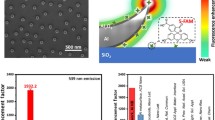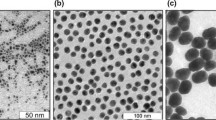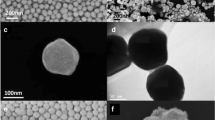Abstract
Reducing the distance between the fluorescence molecules and noble metal (resonant) nanostructures is known to advance the process of electromagnetic coupling and energy transfer, which in return yields fluorescence enhancement particularly exploited for improved biomedical applications. In this study, Au-capped Si nanowhiskers (NWs) at various sizes were fabricated using a vapor–liquid–solid (VLS) mechanism for systematically investigating the dependence of the size of the Au-capped Si NWs on the fluorescence enhancement factor with respect to the fluorescence emission from Rhodamine 6G (Rh-6G) fluorophore. Opposite to what is anticipated from the literature, the maximum enhancement was obtained for the sample for which the Au-nanoparticle (NP) capping is well isolated from the fluorophore and the vertical distance between the fluorophore and the plasmonic metal nanoparticle is largest. Numerical simulations using the finite element method (FEM) were shown to support the experimental optical response results. Four-point probe I-V measurements also show that the Schottky ideality factor of Au-capped Si NWs decays exponentially upon the rise in the fluorescence enhancement factor.

Graphical abstract





Similar content being viewed by others
References
Ayala-Orozco C, Liu JG, Knight MW, Wang Y, Day JK, Nordlander P, Halas NJ (2014) Fluorescence enhancement of molecules inside a gold nanomatryoshka. Nano Lett 14:2926–2933. https://doi.org/10.1021/nl501027j
Holmes JD, Johnston KP, Doty RC, Korgel BA (2000) Control of thickness and orientation of solution-grown silicon nanowires. Science 287:1471–1473. https://doi.org/10.1126/science.287.5457.1471
Karakiz M, Toydemir B, Unal B, Colakerol Arslan L (2014) Growth of shape controlled silicon nanowhiskers by electron beam evaporation. The European Physical Journal Applied Physics 65:20403. https://doi.org/10.1051/epjap/2014130362
Sokolov LV, Gavrilova TA, Werner P et al (2008) Molecular-beam epitaxy-grown Si whisker structures: morphological, optical and electrical properties. Nanotechnology 19:225708. https://doi.org/10.1088/0957-4484/19/22/225708
Schmidt MS, Hübner J, Boisen A (2012) Large area fabrication of leaning silicon nanopillars for surface enhanced Raman spectroscopy. Adv Mater 24:11–18. https://doi.org/10.1002/adma.201103496
Oldenburg SJ, Averitt RD, Westcott SL, Halas NJ (1998) Nanoengineering of optical resonances. Chem Phys Lett 288:243–247. https://doi.org/10.1016/S0009-2614(98)00277-2
Abadeer NS, Brennan MR, Wilson WL, Murphy CJ (2014) Distance and plasmon wavelength dependent fluorescence of molecules bound to silica-coated gold nanorods. ACS Nano 8:8392–8406. https://doi.org/10.1021/nn502887j
Wu Y, Yang P (2001) Direct observation of vapor−liquid−solid nanowire growth. J Am Chem Soc 123:3165–3166. https://doi.org/10.1021/ja0059084
Ge S, Jiang K, Lu X, Chen Y, Wang R, Fan S (2005) Orientation-controlled growth of single-crystal silicon-nanowire arrays. Adv Mater 17:56–61. https://doi.org/10.1002/adma.200400474
Wu Y, Cui Y, Huynh L, Barrelet CJ, Bell DC, Lieber CM (2004) Controlled growth and structures of molecular-scale silicon nanowires. Nano Lett 4:433–436. https://doi.org/10.1021/nl035162i
Yan H, Xing Y, Hang Q et al (2000) Growth of amorphous silicon nanowires via a solid–liquid–solid mechanism. Chem Phys Lett 323:224–228. https://doi.org/10.1016/S0009-2614(00)00519-4
Trentler TJ, Hickman KM, Goel SC, Viano AM, Gibbons PC, Buhro WE (1995) Solution-liquid-solid growth of crystalline III-V semiconductors: an analogy to vapor-liquid-solid growth. Science 270:1791–1794. https://doi.org/10.1126/science.270.5243.1791
Chen SY, Chen LJ (2006) Self-assembled epitaxial NiSi2 nanowires on Si(001) by reactive deposition epitaxy. Thin Solid Films 508:222–225. https://doi.org/10.1016/j.tsf.2005.07.322
Wang Y, Schmidt V, Senz S, Gösele U (2006) Epitaxial growth of silicon nanowires using an aluminium catalyst. Nat Nanotechnol 1:186–189. https://doi.org/10.1038/nnano.2006.133
Zhang R-Q, Lifshitz Y, Lee S-T (2003) Oxide-assisted growth of semiconducting nanowires. Adv Mater 15:635–640. https://doi.org/10.1002/adma.200301641
Yu DP, Lee CS, Bello I, Sun XS, Tang YH, Zhou GW, Bai ZG, Zhang Z, Feng SQ (1998) Synthesis of nano-scale silicon wires by excimer laser ablation at high temperature. Solid State Commun 105:403–407. https://doi.org/10.1016/S0038-1098(97)10143-0
Peng KQ, Hu JJ, Yan YJ, Wu Y, Fang H, Xu Y, Lee ST, Zhu J (2006) Fabrication of single-crystalline silicon nanowires by scratching a silicon surface with catalytic metal particles. Adv Funct Mater 16:387–394. https://doi.org/10.1002/adfm.200500392
Chakraborti S, Basu RN, Panda SK (2018) Vertically aligned silicon nanowire array decorated by Ag or Au nanoparticles as SERS substrate for bio-molecular detection. Plasmonics 13:1057–1080. https://doi.org/10.1007/s11468-017-0605-2
Zhu J, Yu Z, Burkhard GF, Hsu CM, Connor ST, Xu Y, Wang Q, McGehee M, Fan S, Cui Y (2009) Optical absorption enhancement in amorphous silicon nanowire and nanocone arrays. Nano Lett 9:279–282. https://doi.org/10.1021/nl802886y
Attaran A, Emami SD, Soltanian MRK, Penny R, behbahani F, Harun SW, Ahmad H, Abdul-Rashid HA, Moghavvemi M (2014) Circuit model of Fano resonance on tetramers, pentamers, and broken symmetry Pentamers. Plasmonics 9:1303–1313. https://doi.org/10.1007/s11468-014-9743-y
Stöger-Pollach M, Bukvišová K, Schwarz S, Kvapil M, Šamořil T, Horák M (2019) Fundamentals of cathodoluminescence in a STEM: the impact of sample geometry and electron beam energy on light emission of semiconductors. Ultramicroscopy 200:111–124. https://doi.org/10.1016/j.ultramic.2019.03.001
Ge W, Zhang X, Liu M, et al (2014) Plasmonic properties of Au/SiO2 nanoparticles: effect of gold size and silica dielectric layer thickness. Materials Research Innovations 18:S4-701-S4-705. https://doi.org/10.1179/1432891714Z.000000000769
Sharma R, Roopak S, Kumar PN et al (2017) Study of surface plasmon resonances of core-shell nanosphere: a comparison between numerical and analytical approach. Plasmonics 12:977–986. https://doi.org/10.1007/s11468-016-0349-4
Nomura K-I, Fujii S, Ohki Y, Awazu K, Fujimaki M, Tominaga J, Fukuda N, Hirakawa T, Rockstuhl C (2008) Fabrication of inert silver nanoparticles with a thin silica coating. Jpn J Appl Phys 47:8641–8643. https://doi.org/10.1143/JJAP.47.8641
Mandal A, Chaudhuri P (2013) Controlling the absorption spectrum within a thin amorphous silicon layer by using the size dependent plasmonic behaviour of silver nanoparticles. Journal of Renewable and Sustainable Energy 5:031614. https://doi.org/10.1063/1.4809787
Vyas H, Hegde RS (2019) Waveguide interrogation of a compound plasmonic nanoantenna. Journal of Nanophotonics 13:1. https://doi.org/10.1117/1.JNP.13.026004
Taheri M, Hajiesmaeilbaigi F, Motamedi AS, Golian Y (2015) Nonlinear optical response of gold/silicon nanocomposite prepared by consecutive laser ablation. Laser Physics 25:. https://doi.org/10.1088/1054-660X/25/6/065901, 25
Ferdous N, Ertekin E (2018) Atomic scale origins of sub-band gap optical absorption in gold-hyperdoped silicon. AIP Adv 8:55014. https://doi.org/10.1063/1.5023110
Ghosh R, Imakita K, Fujii M, Giri PK (2016) Effect of Ag/Au bilayer assisted etching on the strongly enhanced photoluminescence and visible light photocatalysis by Si nanowire arrays. Phys Chem Chem Phys 18:7715–7727. https://doi.org/10.1039/C5CP07161E
Mei Z, Tang L (2017) Surface-plasmon-coupled fluorescence enhancement based on ordered gold nanorod array biochip for ultrasensitive DNA analysis. Anal Chem 89:633–639. https://doi.org/10.1021/acs.analchem.6b02797
Drake C, Deshpande S, Bera D, Seal S (2007) Metallic nanostructured materials based sensors. Int Mater Rev 52:289–317. https://doi.org/10.1179/174328007X212481
Williamson G, Hall W (1953) X-ray line broadening from filed aluminium and wolfram. Acta Metall 1:22–31. https://doi.org/10.1016/0001-6160(53)90006-6
Mote V, Purushotham Y, Dole B (2012) Williamson-Hall analysis in estimation of lattice strain in nanometer-sized ZnO particles. Journal of Theoretical and Applied Physics 6:6. https://doi.org/10.1186/2251-7235-6-6
Cantwell PR, Kim H, Schneider MM, Hsu HH, Peroulis D, Stach EA, Strachan A (2012) Estimating the in-plane Young’s modulus of polycrystalline films in MEMS. J Microelectromech Syst 21:840–849. https://doi.org/10.1109/JMEMS.2012.2191939
Cheung SK, Cheung NW (1986) Extraction of Schottky diode parameters from forward current-voltage characteristics. Appl Phys Lett 49:85–87. https://doi.org/10.1063/1.97359
Acknowledgments
The authors acknowledge the support provided by Bilkent University UNAM.
Author information
Authors and Affiliations
Contributions
The works in the project were coordinated by Dr. İsa Şeker. The manuscript was written by Dr. İsa Şeker and Dr. Ali Karatutlu. The numerical analyses were performed by Dr. Ali Karatutlu and Dr. Bülend Ortaç. Fabrication of Au-capped Si NWs were conducted by Dr. İsa Şeker and Dr. Mehmet Karakız. Fluorescence enhancement studies of Rh-6G were conducted and recorded by Dr. İsa Şeker and Dr. Kurtuluş Gölcük. Dr. Ali Karatutlu and Dr. İsa Şeker also performed the morphological, structural, and electrical analyses of Au-capped Si NWs.
Corresponding authors
Ethics declarations
Conflicts of Interest
The authors declare that they have no conflict interest.
Additional information
Publisher’s Note
Springer Nature remains neutral with regard to jurisdictional claims in published maps and institutional affiliations.
Electronic supplementary material
ESM 1
(DOCX 67 kb)
Rights and permissions
About this article
Cite this article
Şeker, İ., Karatutlu, A., Gölcük, K. et al. A Systematic Study on Au-Capped Si Nanowhiskers for Size-Dependent Improved Biosensing Applications. Plasmonics 15, 1739–1745 (2020). https://doi.org/10.1007/s11468-020-01195-7
Received:
Accepted:
Published:
Issue Date:
DOI: https://doi.org/10.1007/s11468-020-01195-7




